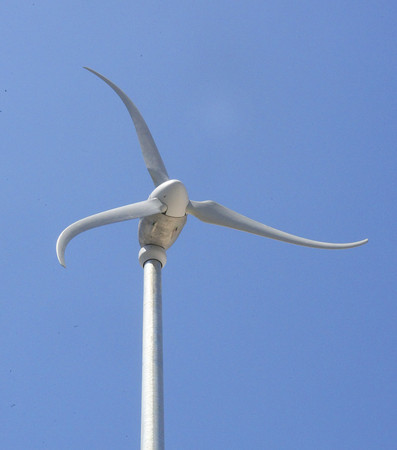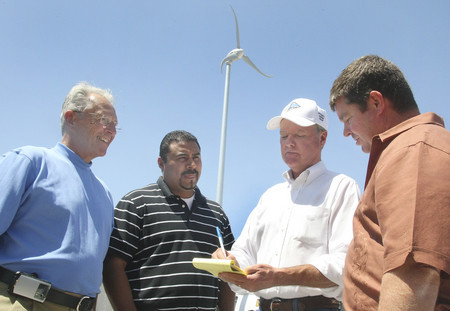NV Energy, federal government offer incentives to defray wind generator cost
The goal Friday was to install a machine that harnesses the wind, but there were worries that it might be too windy.
Allen McLane, an electrical contractor who has a wind-powered generator at his house in northwest Las Vegas, found that it was windy in his neighborhood that morning, and wondered whether that would keep the tall pole on which the propeller sits from setting properly.
But when he got to the job site -- Premier Mechanical, in an industrial park near the Palms -- it was dead calm. That's not great for generating wind power, but it's perfect for installing a system.
More of these systems, which are intended for homes or individual businesses, are expected to be installed in the near future, said McLane and Steve Stoney of NV Energy.
NV Energy and the federal government offer incentives to defray the cost of the system, which averages about $20,000. The city of Las Vegas, meanwhile, is considering new rules that would allow the generators to be installed in more areas of the city.
The utility company has been running its rebate program for about a year. There are roughly 20 of these generators in the Reno area and three in Southern Nevada including the one installed Friday, which is the first in Las Vegas at a business.
"It's built slowly because people have to first believe that this will work for them," Stoney said.
Whether it will depends a lot on location, he said. The western side of the valley, toward the mountains, probably offers the best wind conditions. As more systems are installed, the pool of data about hot spots for wind will grow.
"We need a whole year of data to know how it does," McLane said. "Two years, really."
In Las Vegas, small wind energy systems can be installed on properties of at least two acres. Councilman Steve Ross has proposed an ordinance that removes the lot size requirement and sets rules for the height of the systems. It's scheduled to go before the City Council in September.
"I want the city of Las Vegas to be on the cutting edge of allowing its residents to make decisions on renewable energy in their homes," Ross said. "I'm really pushing this."
Technological development has made the systems quieter, he said. The generators are rated at 50 decibels, about as loud as a normal conversation a few feet away.
A user can expect the systems to generate 1 kilowatt of power a month, McLane said. A typical house uses 1 to 2 kilowatts a month.
Premier Mechanical had a more ambitious goal: 2.5 kilowatts per month, a little more than half of the power the shop uses making metal ducts for commercial and government buildings.
That might not be realistic because the wind doesn't blow constantly, McLane said. The system at his house hasn't generated much power yet because the wind hasn't been active this summer (with the exception of Thursday, which was blustery).
The rebates combined with power savings and a reduced carbon footprint could make the systems worth it.
"Any help to a homeowner to get their power bill down is significant," Ross said. "It would just make me feel good that my power meter isn't spinning like crazy."
Contact reporter Alan Choate at achoate@reviewjournal.com or 702-229-6435.
WIND POWER REBATES
NV Energy is accepting applications from people installing wind generators on their properties.
The incentives are $2.50 per watt up to 10 kilowatts and $1.50 per watt above 10 kilowatts.
The federal stimulus bill expanded an existing tax credit for new renewable energy systems, including small wind turbines. The credit is 30 percent of the cost of the system if it's put into service before Dec. 31, 2016.























